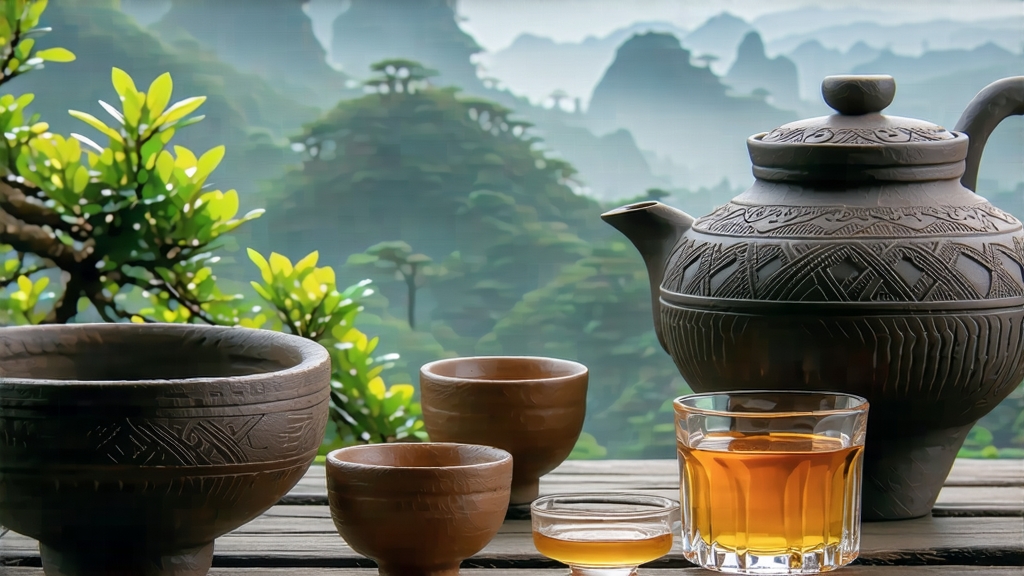
Few leaves carry as much myth, craftsmanship and shifting fashion as Tie Guan Yin, the “Iron Goddess of Mercy” that springs from the granite soils of southern Fujian’s Anxi county. To the Chinese tea world she is simultaneously a household comfort and a connoisseur’s riddle: one bush, a dozen processing styles, and an aroma that can recall everything from fresh orchids to roasted chestnuts depending on the season, the village, and the maker’s mood. For international drinkers who have met only the floral supermarket version, the real spectrum of Tie Guan Yin can be astonishing—an invitation to taste how a single cultivar can echo both green tea’s brightness and dark oolong’s warm malt, while still declaring its own unmistakable identity.
Origin stories swirl like mountain clouds. The most beloved tells of a devout farmer named Wei Yin who, in the early eighteenth century, found a deserted iron statue of Guan Yin, the Bodhisattva of Compassion, hidden in a grotto. He dusted it daily, prayed, and one night dreamed of a cave behind the statue where a single tea tree shimmered in moonlight. Upon waking he discovered the tree, transplanted it, and the leaves brewed into a liquor so fragrant that neighbors believed the goddess herself had lent the tea its lingering sweetness. Whether myth or marketing, the tale underlines the spiritual aura that still wraps Tie Guan Yin; even today, the finest lots are offered first to the goddess before they reach market.
Anxi’s topography is the first secret. The county lies where the Wuyi range tumbles toward the Fujian coast, creating a maze of narrow valleys whose granite bedrock weathers into acidic, mineral-rich soils. Morning fog from the Jin River basin traps humidity, while sharp afternoon sun stresses the leaves, concentrating aromatic amino acids. Elevation varies from 200 m in the outer townships to 1,200 m on the cloud-capped peaks of Xiping and Gande. High-grown tea, slower to mature, develops thinner but more fragrant leaf; lower gardens yield plumper shoots that stand up to heavier oxidation. Thus the same cultivar—botanically classified as Camellia sinensis var. sinensis ‘Tie Guan Yin’—can express either airy elegance or creamy depth depending on which slope it calls home.
Traditional Tie Guan Yin is a five-act play of withering, bruising, partial oxidation, fixation, and charcoal baking. After picking, the leaves are spread on bamboo trays and allowed to wilt for two to four hours, losing about 10 % moisture. What follows is the critical “green in the middle, red at the edge” phase: skilled artisans toss the leaves in giant cylindrical bamboo drums, tumbling them just hard enough to rupture cell walls along the serrated leaf margins while keeping the central vein intact. Oxidation creeps in at 25–30 %, far less than the 60–70 % of Da Hong Pao but more than the 15 % of Wen Shan Bao Zhong. A quick wok firing at 280 °C halts enzymatic activity, locking in a jade-green center framed by coppery rims. Finally, the tea is wrapped in cloth balls and rolled under mechanical pressure, twisting each leaf into the signature dragonfly-head shape, then baked over a gentle charcoal fire of longan fruitwood for up to forty hours. The result is a strip that feels crisp yet elastic, dark emerald flecked with rust, releasing a scent that marries orchid with warm toast.
Since the 1990s, market demand has splintered Tie Guan Yin into stylistic camps. “Qing Xiang” (light fragrance) skips the charcoal step, relying instead on modern climate-controlled rooms that preserve high floral notes—think white lilies and fresh cream. It steeps neon-green and dances on the palate like a spring oolong crossed with gyokuro. “Nong Xiang” (heavy fragrance) returns to longan-charcoal baking, yielding a deeper amber liquor, rounded body, and a lingering honey-roasted finish. Between the two sits “Xiao Qing” (moderate green), oxidized slightly longer than Qing Xiang but baked only once, offering a bridge for newcomers. Purists argue that only charcoal-baked versions age gracefully, developing prune-like sweetness and medicinal coolness after five to ten years in unglazed clay jars, while modern green styles are best consumed within eighteen months before their volatile esters fade.
Craft mastery is measured in tiny